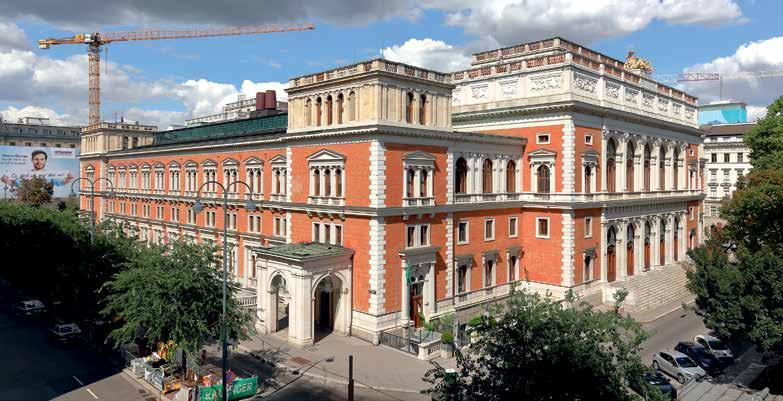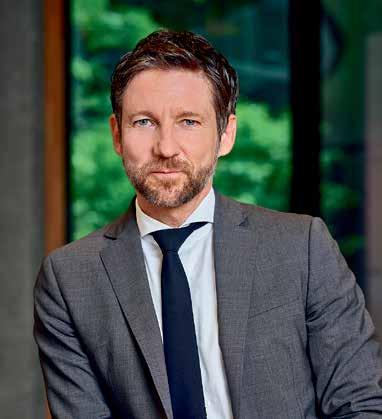
9 minute read
Austria’s stock exchange has a long tradition
by medianet
The Vienna Stock Exchange celebrates its 250 years anniversary. Austrians have rediscovered their love for stocks during the Covid pandemic.
j by Reinhard Krémer
Advertisement
For Austria’s financial market, 2021 is a year of celebration: it is the Vienna Stock Exchange’s (Wiener Börse) 250th anniversary. Founded in 1771 by Empress Maria Theresa, it is one of the oldest national stock exchanges in the world. But upholding tradition is only one facet, its cutting-edge technology and constant awareness of future trends are key features of the Austrian stock exchange. To mark this special occasion, the Vienna Stock Exchange is launching a future forum this year, which will host domestic and international experts on a regular basis to discuss innovation, change and the economy of the future.
The anniversary year was opened with a congratulatory message from Austria’s President Alexander Van der Bellen: “The Vienna Stock Exchange has made an exciting journey. Maria Theresa attracted progressive entrepreneurs to Vienna, stimulated the economy while at the same time also laying the foundation for today’s stock exchange. It continues to play a crucial role to this very day. In dealing with the pandemic, companies need courage, confidence, trust and, of course, a strong equity base. This will help accelerate economic recovery.” His full video message can be viewed online.
Ten years until its inception
“Beethoven, whose 250th anniversary of his birth was last year, was one of the first shareholders in Austria. And he also knew: if you want to create wealth, the stock market calls the tune. This has not changed in 250 years. It becomes especially clear in times of crisis like the current pandemic that economies with developed capital markets are more resilient. We will be discussing this topic and many others at our future forum this year,” explains Christoph Boschan, CEO of the stock exchange’s operating company Wiener Börse AG.
The first efforts to establish a stock exchange in Austria were made in 1761. Ten years later, the plans were put into practice. On 1 August 1771, Maria Theresa issued the charter establishing the state-run stock exchange with the aim of strengthening confidence in the state finances of the Habsburg monarchy. The first day of trading took place on 2 September 1771. Initially, only bonds, bills
© PhilippLipiarski

Stocks were traded in the old stock exchange along Vienna’s Ringstrasse as of 1877; since 2002 the stock exchange is located on Wallnerstrasse.
of exchange and foreign currencies were traded. Stockbrokers, called “Sensale” on the Vienna Stock Exchange, ensured smooth trading and received a commission. The first stock exchange was located at Kohlmarkt 12 (now Kohlmarkt 16). It moved several times over the course of the next 250 years and today it resides – not far from its first location – on Wallnerstrasse 8.
The shares of the Austrian central bank were the first to be listed in Vienna in 1818. Since 1869, investors have been able to trade in the shares of Porr AG and Wienerberger AG, the two longest listed companies on the Vienna Stock Exchange. In 1991, the Austrian benchmark index ATX, was launched and trading became increasingly automated. With the introduction of the Xetra system in 1999, trading became fully automated. The internationalisation of the market advanced rapidly with the connection of foreign banks to the exchange. With cooperation agreements in Central and Eastern Europe, and in the mid-2000s also through equity investments, Wiener Börse acquired partners in the region. Today, its focus as a regional player is on providing stock market infrastructure and IT services. Hardly any other European stock exchange of similar size has a comparable degree of diversification and efficiency as the Vienna Stock Exchange.
“Throughout our 250-year-long history and despite technological modernisation, our fundamental mission has not changed. We are the central marketplace for the pricing of securities. Our offerings and our reliability create trust and ensure transparency. We prove this every day operating in a highly regulated environment with fierce competition,” says Boschan.
The ATX is 30 years old
The ATX tracks the performance of the 20 largest and most actively traded stocks on the Vienna Stock Exchange. The Austrian national index ATX also celebrates a special anniversary. On 13 May, the birthday of the founder of the Vienna Stock Exchange Maria Theresa, the Austrian stock exchange barometer was published for the first time. At the close of trading on 13 May 1991, a score of 1,192.95 flickered across the TV screens. 30 years later, the Austrian national index showed 6,688.08 points including dividends on 10 May (excl. dividends: 3,376.39 points). Thus, it is close to its all-time high of 6,727.44 points (9 July 2007). Investors who have consistently invested in ATX shares since the beginning of January 1991 can today look at a total performance of +678 % (annual average return: 6.51 %).
Stock Exchange Award for the best
The presentation of the Vienna Stock Exchange Award took place again in 2021. Year after year, the award winners are independently evaluated by expert juries of the ÖVFA (ATX, Mid Cap
and Corporate Bond Award), financial journalists coordinated by APA-Finance (Journalist Award) and the VÖNIX Advisory Board (Sustainability Award). The winners received their awards, staggered according to the five categories, at the Vienna Stock Exchange.
Wienerberger AG was able to win the prime category, the ATX award, due to its good performance in the extraordinary Covid-year 2020, very good financial reporting and ongoing investor relations activities. According to the ÖVFA jury, a seamless flow of information, the commitment of the Management Board to investor relations, analysts and investors, a sustainable focus on ESG and a focus on digitisation contributed to the decision. In addition, Wienerberger AG was also awarded the Corporate Bond Award. In the Sustainability Category, Agrana-Beteiligungs AG, BKS Bank AG and Palfinger AG received the Vienna Stock Exchange Award in 2021. They are part of the VÖNIX universe (the sustainability benchmark of the Austrian financial market) and are therefore evaluated for the Sustainability Award; the other categories (ATX, Mid Cap, Corporate Bond, Journalists) only consider ATX and prime market instruments. All three companies received this award for the first time, based on the VÖNIX rating 2020/2021.
AMAG Austria Metall AG won a Mid Cap Award for the fourth time and for the first time takes first place. The jury’s reasoning: The company achieved top scores in the criteria of financial reporting and investor relations. Likewise, in the areas of strategy and corporate governance, AMAG Austria Metall AG ranked at the top in the opinion of the jury.
The Journalist Award went to Erste Group Bank AG for the second year in a row. The jury of APA-Finance praises the sovereign, professional, fast as well as open communication. Erste Group Bank AG scores with good accessibility, high transparency, professional documentation and is also available for background discussions.

Changing behaviour
Lockdowns, high unemployment and short-time work schemes are still burdening the financial situation of many Austrians. This has an effect on their savings and investment behaviour. The willingness to invest is currently still low but the outlook for the next twelve months is already more optimistic, a survey of 1,000 people by Erste Bank shows.
After months of Covid crisis, people long strongly for a financial cushion. According to the representative survey, 38 percent of people said that they would rather leave their money in their bank account due to existential fears. This is backed up by a few figures: In 2020, the sight and saving deposits of private households amount to almost 190 billion euros in Austria. That is about 20 billion euros more than in 2019 (170 billion euros). The increase of 11.9 percent was caused mainly by the Covid-induced lockdowns as households were unable to spend their money and the numerous insecurities that came along.
“Hoarding cash is understandable in some cases but a disadvantage in the long term,” says Thomas Schaufler, Member of the Board for Private Banking at Erste Group. “Inflation and zero interest rates are eating into the cash reserves every day.” The recommendation to have about three net monthly incomes available at all times and invest these savings in a way that an inflation-adjusted asset remains, is still valid. According to the survey, 18 percent said that they “invested more money to yield a

Erste Group Bank has 16 million customers in CEE. Founded in 1819, it is one of the largest financial service providers in Central and Eastern Europe.
return”. For 17 percent, consumption comes first – they rather spend money then invest it. It is cause for alarm, however, that one in four people is unable to save any money due to their precarious financial situation.
New love for stocks
People appear to be more optimistic when it came to savings and investments over the next twelve months, the survey showed: Eight in ten Austrians want to invest their money. On average, they plan with an investment budget of 4,800 euros – 200 euros more than in the same period 1/2020. Classic types such as savings accounts (57 percent, minus one percentage point) and building society contracts (39 percent, -2 p.p.) remain first choice, followed by pension provision (31 percent, +4 p.p.) and life insurance (30 percent, +3 p.p.).
Funds, stocks and bonds are gaining slowly but steadily more interest among those surveyed: 32 percent (+2 p.p.) want to invest into stocks. “The trend is moving in the right direction as you can’t yield a return without securities. We also notice an increased demand particularly in sustainable investment funds,” says Schaufler. The largest increase in investment types can be found in real estate (19 percent), up by six percentage points. One in three people (34 percent, -3 p.p.) are planning a larger purchase in the near future and earmark a budget of 116,400 euros. This amount went up considerably compared to the previous year (93,800 euros) by 24 percent. Those surveyed still want to finance this purchase mainly with their own savings. But compared to Q1/2020, more Austrians want to use a bank loan or a building society loan (20 percent, +6 p.p.).
Different payment behaviour
Since the outbreak of the Covid pandemic paying by bank card or credit card has been booming among Austrians. For the first time in history more than 1.2 billion transactions have been processed by debit cards in 2020 in Austria. “We are still seeing a third more transactions than the previous year,“ Schaufler says.
Opinions on whether the boom in card payments will continue after the Covid crisis differs among Austrians: 48 percent say that they can imagine going back to using more cash again while 49 percent believe that the increased use of cards will stay. “The pandemic showed many people the advantages of card payment and took many reservations away. We see this across all age groups – even older people are now paying with their phones as if they had always done so,” Schaufler explains.” ◆










